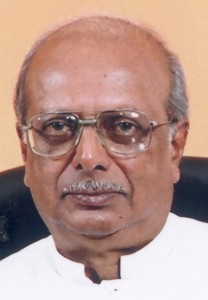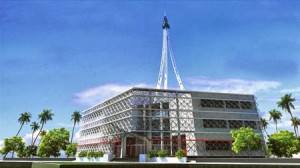Nanotechnology: Path to rapid economic development
On October 21 when President, Mahinda Rajapaksa, opened SLINTEC, the Nanotechnology Laboratory Complex of the Nanoscience Park at Homagama, it was indeed a landmark occasion in the history of Sri Lanka. Through this we have firmly

Prof. Tissa Vitarana
joined the countries riding the new wave of advanced technology, Nanotechnology that is sweeping the world to a higher level of development.
In the past, countries have left poverty behind and become developed rich industrialised economies by catching the successive waves of technology that have swept through the world. Europe, Britain in particular, followed by the USA, caught the Industrial Revolution. Japan and Taiwan caught the wave of Electronics. South Korea caught the waves of microelectronics, information communication technology (ICT) and advanced materials technology. China and India have in addition moved into biotechnology. Sri Lanka missed these buses. We can be glad that we have caught the Nanotechnology bus. It will also enable us to come up in other advanced technologies like biotechnology (Nanobio), electronics (Nanoelectronics) etc.
As I made clear when I got Cabinet approval for the National Science, Technology and Innovation Strategy in 2010, Sri Lanka must leave behind its colonial legacy of being an exporter of raw materials and low value added products, and become instead an exporter of high value added (Hi-tech) products. It is because the Hi-tech component of exports from Japan is 85 per cent, South Korea 70 per cent, Singapore 60 per cent and Malaysia 50 per cent, that they have become rich developed economies, or are on that path. It is indeed sad that Sri Lanka has only 1.5 per cent of Hi-tech manufactured products in its exports. But now Sri Lanka too can follow that path beginning with SLINTEC.
Sri Lanka’s Nanotechnology journey has been an arduous one, with many twists and turns, and many people helped to take the process forward, while some even obstructed. I shall make mention of a few key players to whom the whole country is indebted. After I became the Minister of Science and Technology in 2004, I discussed with Prof. Sirimali Fernando, the new Chairperson of the National Science Foundation (NSF), the need for developing our capability in advanced technologies. We thought first of biotechnology, which had just taken off in Sri Lanka. But she drew my attention to Nanotechnology which was an emerging technology in which we could be a leader as few countries had tapped it and only 17 countries had national Nanotechnology programmes at that time. We had expertise among Sri Lankans here and abroad, and as it was cross-cutting it would help our progress in other Hi-tech areas too. With the help of the National Science Foundation a Task Force was set up. With the Board of the NSF, taking the observations of the Nanotech Taskforce, a National Nanotechnology Initiative (NNI) was drafted. Prof. Ravi Silva of the Advanced Technology Centre of the University of Surrey made a significant contribution to the process.In 2005, along with Prof. Ravi Silva and Prof. Fernando, I presented this to President Mahinda Rajapaksa, and he readily accepted the idea. Thereafter several others gave their support. Among them were Lalith Weeratunge, Mahesh Amalean, Ashrof Omar, Tissa Jinasena, Ananda Hettiarachchi, Dr. Hans Wijesuriya, Prof. E. Epasinghe, Prof. Gamini Rajapakse and Prof. Gehan Ameratunge. Finally the Cabinet Paper to launch the NNI was tabled by the President in August 2006, with the total budgetary requirement of Rs.5.6 billion to be provided by Government over 5 years. I set up an international expert advisory panel to help composed of Professors Ravi Silva, Gehan Ameratunge, Kumar Wickremasinghe and A.P. de Silva.
The 60 acres of land at Mahanewatte, Pitipana, was acquired by the UDA with the support of Minister Dinesh Gunewardene, and the key role of A.N.R. Ameratunge, Secretary of the Ministry of Science and Technology, in getting the land together with the requisite facilities must be acknowledged. However In the context of the war, obtaining the required funding became a major hurdle specially as there was some local skepticism about the viability of the project, and this was also shared by foreign donor agencies.This forced us to organise an intensive campaign in favour of the NNI to obtain private sector industrialist participation with the necessary funding commitment.
With the President and Dr. P B Jayasundera, Secretary to the Treasury agreeing, a private public partnership (PPP) was established on a 50:50 basis to take the NNI forward. This was approved by the Cabinet in August 2007. The Government provided the land and the equipment for the nanoscience centre, SLINTEC, while the private sector agreed to run the centre as equal partners. The founder shareholders of SLINTEC were MAS Holdings, Brandix, Hayleys, Loadstar and Dialog from the private sector, and the NSF from the Government side. In April 2008 SLINTEC (Pvt) Ltd was incorporated. The

Nanoscience Park at Homagama
commitment of the Board, led by Mahesh Amalean as Chairman, supported by Prof. Sirimali Fernando, who coordinated all activities related to NNI, added the dynamism of the private sector to the vision of the Government, establishing a magnificent model for the future development of our country.
In view of the delay in getting the project started in Homagama, as an interim arrangement the SLINTEC laboratory was set up in the MAS Holdings building in the Biyagama FTZ. It is a tribute to all concerned that a world class laboratory was established in the short period of 8 months. Scientists were recruited from the universities, research institutes and from abroad (reversing the brain drain) to conduct targeted time bound research for the private sector partners and the government. That they responded excellently to the challenge, and in the first year alone five international (USA) patent applications were filed, was a clear indication of their ability to adapt to the needs of our industry and the country once they were provided with the necessary facilities in an enabling environment.
The benefit that SLINTEC can bring to our economy can be seen by the following two examples. It has already developed a method for the conversion of ilmenite to titanium dioxide and is in the process of transferring the technology to Laughfs Gas Co. This would help us to stop the practice of exporting ilmenite containing raw earth, which has been going on from the time we were a colony of Britain, for the average figure of US$8 million per year, while we spend $12 million on the import of the small quantity of titanium dioxide required by our paint industry. The outcome would be the promotion of local industry, and not only the saving of foreign exchange but also increasing our income by exporting titanium dioxide in the future. The other example is the sale by SLINTEC of some patent rights for the process developed for the slow release of urea fertiliser. The money earned from this single transaction was sufficient to cover the entire equity (Rs. 420 million) of both the private sector and the government in forming SLINTEC.
The National Nanotechnology Initiative has helped to take forward the objectives of the National Science, Technology and Innovation Strategy (NSTIS). It has (a) promoted a new research commercialisation culture among local scientists, (b) created an interest in technological innovation among the private sector, as reflected in the increase of the private sector contribution to national R&D expenditure from 1 per cent in 2004 to 20 per cent in 2008, and (c) provided a platform for close collaboration between researchers and industry in the use of advanced technology for high value addition to our raw materials. This augurs well for our future as a true knowledge hub that can make us a rich developed country. As the Minister of Scientific Affairs I am taking the NSTIS process forward by the establishment of the coordinating mechanism, COSTI. It is my hope that the present Minister of Technology and Research, Champika Ranawake, and all other relevant Ministers like the Minister of Higher Education, the Minister of Trade and Industry and the Minister of Agriculture will jointly help to take forward this process of science based rapid economic development.



